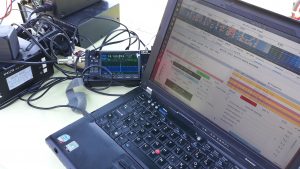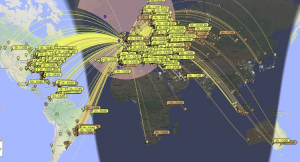Listen to radio amateurs without a radio!
 Thanks to the internet, it’s possible to listen on amateur radio frequencies without a special short wave receiver.
Thanks to the internet, it’s possible to listen on amateur radio frequencies without a special short wave receiver.
There are many WebSDR (Software-Defined Radio) receivers connected to the internet, allowing multiple users to listen simultaneously.
A list of WebSDR receivers and links to them is at http://www.websdr.org/
To use WebSDR…
- Navigate to a receiver like Hack Green, Cheshire (one of the closest WebSDRs to Birmingham) or KFS WebSDR in California (where you can listen in to the US amateurs).
- Once on a WebSDR site, enable ‘allow keyboard’, which permits you to tune the receiver using mouse wheel or keyboard arrows.
- You may have to enable audio settings on your browser – see the advice on each webSDR site; eg for listening to Hack Green using Chrome: Click the Lock in the address bar of your Chrome browser. Click Site Settings. Under Sound, select Allow.
- Select the band you want to listen on – you will find most stations on 80, 40 and 20 meters, in the frequency ranges in the table below.
- When listening on 80 and 40 meters, select LSB (lower side band); when listening on 20 meters, select USB (upper side band).
- Once you hear a station, it may sound like ‘Donald Duck’ – tune slowly and the voices will become clear
- Once you become proficient at tuning in stations, try some of the other receiver functions – e.g. narrow IF bandwidth and IF passband can be used to reduce interference.
Over the next few months, you can expect the following radio conditions:
| Amateur band
(meters) |
For SSB (voice) tune these frequencies and select LSB or USB as indicated | Expected coverage if listening to Hack Green
(More detail on propogation predictions here)
|
| 80m | 3700-3800 LSB | Daytime – UK; Evening – UK and continental Europe |
| 40m | 7100-7200 LSB | Daytime – continental Europe (sometimes UK); Evening – Europe, and occasionally further afield |
| 20m | 14150-14300 USB | Daytime – Europe; Evening – Europe and often further afield |
 CALL SIGNS
CALL SIGNS
You can identify the countries from which stations are operating by comparing their call sign prefix (the first one or two letters/numbers) with those on the list of international call sign prefixes e.g. the Wythall Radio Club call sign is G4WAC – G means the station is in England.
Q CODES AND OTHER SHORTHAND YOU MAY HEAR
You may hear the following…
CQ, CQ – I am calling for a contact; please reply to me
DX – long distance (normally, outside the operator’s continent)
QRZ? – is anyone there?
QTH – location of the station
QRM – interference on the signal
QSB – fading on the signal
QSL – confirmation of the contact or information passed
73s – best wishes and goodbye
GAINING AN AMATEUR RADIO LICENCE
The ‘Foundation licence’ is not difficult to obtain. There is some simple electronics and radio operating to study. You can find details of the licence levels and courses on the Wythall Radio Club web site and there is more information at the RSGB.

